Valorization of Hemp Core Residues: Impact of NaOH Treatment on the Flexural Strength of PP Composites and Intrinsic Flexural Strength of Hemp Core Fibers
Abstract
1. Introduction
2. Materials and Methods
2.1. Materials
2.2. Methods
2.2.1. Hemp Core Fibers Treatment
2.2.2. Composites Preparation and Sample Obtaining
2.2.3. Mechanical Test
3. Results
3.1. Effect of Sodium Hydroxide (NaOH) Treatment on Hemp Core Fibers
3.2. Optimization of the Coupling Agent
3.3. Flexural Properties of Hemp Core Fiber Composites
3.4. Modeling the Flexural Strength
3.5. Hemp Core Fibers Intrinsic Flexural Strength
4. Conclusions
Author Contributions
Funding
Acknowledgments
Conflicts of Interest
References
- Scarponi, C.; Messano, M. Comparative evaluation between E-Glass and hemp fiber composites application in rotorcraft interiors. Compos. Part B Eng. 2015, 69, 542–549. [Google Scholar] [CrossRef]
- Al-Oqla, F.M.; Salit, M.S. Materials Selection for Natural Fiber Composites; Elsevier: Amsterdam, The Netherlands, 2017. [Google Scholar]
- Joshi, S.; Drzal, L.; Mohanty, A.; Arora, S. Are natural fiber composites environmentally superior to glass fiber reinforced composites? Compos. Part A Appl. Sci. Manuf. 2004, 35, 371–376. [Google Scholar] [CrossRef]
- Bledzki, A.K.; Gassan, J. Composites reinforced with cellulose based fibres. Prog. Polym. Sci. 1999, 24, 221–274. [Google Scholar] [CrossRef]
- Vijaya-Ramnath, B.; Junaid-Kokan, S.; Niranjan-Raja, R.; Sathyanarayanan, R.; Elanchezhian, C.; Rajendra-Prasad, A.; Manickavasagam, V.M. Evaluation of mechanical properties of abaca-jute-glass fibre reinforced epoxy composite. Mater. Des. 2013, 51, 357–366. [Google Scholar] [CrossRef]
- Balart, J.F.; Fombuena, V.; Fenollar, O.; Boronat, T.; Sánchez-Nacher, L. Processing and characterization of high environmental efficiency composites based on PLA and hazelnut shell flour (HSF) with biobased plasticizers derived from epoxidized linseed oil (ELO). Compos. Part B Eng. 2016, 86, 168–177. [Google Scholar] [CrossRef]
- Wool, R.; Sun, X.S. Bio-Based Polymers and Composites; Elsevier: Amsterdam, The Netherlands, 2011. [Google Scholar]
- Valdés, A.; Fenollar, O.; Beltrán, A.; Balart, R.; Fortunati, E.; Kenny, J.M.; Garrigós, M.C. Characterization and enzymatic degradation study of poly(ε-caprolactone)-based biocomposites from almond agricultural by-products. Polym. Degrad. Stab. 2016, 132, 181–190. [Google Scholar] [CrossRef]
- Väisänen, T.; Haapala, A.; Lappalainen, R.; Tomppo, L. Utilization of agricultural and forest industry waste and residues in natural fiber-polymer composites: A review. Waste Manag. 2016, 54, 62–73. [Google Scholar] [CrossRef]
- Haque, A.; Mondal, D.; Khan, I.; Usmani, M.A.; Bhat, A.H.; Gazal, U. Fabrication of composites reinforced with lignocellulosic materials from agricultural biomass. Lignocellul. Fibre Biomass-Based Compos. Mater. Process. Prop. Appl. 2017. [Google Scholar] [CrossRef]
- Serra-Parareda, F.; Tarrés, Q.; Espinach, F.X.; Vilaseca, F.; Mutjé, P.; Delgado-Aguilar, M. Influence of lignin content on the intrinsic modulus of natural fibers and on the stiffness of composite materials. Int. J. Biol. Macromol. 2020, 155, 81–90. [Google Scholar] [CrossRef]
- Serra-Parareda, F.; Tarrés, Q.; Delgado-Aguilar, M.; Espinach, F.X.; Mutjé, P.; Vilaseca, F. Biobased Composites from Biobased-Polyethylene and Barley Thermomechanical Fibers: Micromechanics of Composites. Materials 2019, 12, 4182. [Google Scholar] [CrossRef]
- Beaugrand, J.; Nottez, M.; Konnerth, J.; Bourmaud, A. Multi-scale analysis of the structure and mechanical performance of woody hemp core and the dependence on the sampling location. Ind. Crops Prod. 2014, 60, 193–204. [Google Scholar] [CrossRef]
- Stevulova, N.; Cigasova, J.; Estokova, A.; Terpakova, E.; Geffert, A.; Kacik, F.; Singovszka, E.; Holub, M. Properties Characterization of Chemically Modified Hemp Hurds. Materials 2014, 7, 8131–8150. [Google Scholar] [CrossRef] [PubMed]
- Balčiunas, G.; Vejelis, S.; Vaitkus, S.; Kairyte, A. Physical properties and structure of composite made by using hemp hurds and different binding materials. Procedia Eng. 2013, 57, 159–166. [Google Scholar] [CrossRef]
- Geissdoerfer, M.; Savaget, P.; Bocke, N.M.P.; Hultink, E.J. The Circular Economy–A new sustainability paradigm? J. Clean. Prod. 2017, 143, 757–768. [Google Scholar] [CrossRef]
- Stahel, W.R. The circular economy. Nature 2016, 531, 435–438. [Google Scholar] [CrossRef] [PubMed]
- Anastas, P.T.; Warner, J.C. Principles of Green Chemistry. Green Chem. Theory Pract; Oxford University Press: New York, NY, USA, 1998; p. 30. [Google Scholar]
- Battegazzore, D.; Noori, A.; Frache, A. Hemp hurd and alfalfa as particle filler to improve the thermo-mechanical and fire retardant properties of poly(3-hydroxybutyrate-co-3-hydroxyhexanoate). Polym. Compos. 2019, 40, 3429–3437. [Google Scholar] [CrossRef]
- Khoathane, M.C.; Vorster, O.C.; Sadiku, E.R. Hemp Fiber-Reinforced 1-Pentene/Polypropylene Copolymer: The Effect of Fiber Loading on the Mechanical and Thermal Characteristics of the Composites. J. Reinf. Plast. Compos. 2008, 27, 1533–1544. [Google Scholar] [CrossRef]
- Shahzad, A. Hemp fiber and its composites—A review. J. Compos. Mater. 2012, 46, 973–986. [Google Scholar] [CrossRef]
- Li, X.; Tabil, L.G.; Panigrahi, S. Chemical treatments of natural fiber for use in natural fiber-reinforced composites: A review. J. Polym. Environ. 2007, 15, 25–33. [Google Scholar] [CrossRef]
- Culebras, M.; Sanchis, M.J.; Beaucamp, A.; Carsí, M.; Kandola, B.K.; Horrocks, A.R.; Panzetti, G.; Birkinshaw, C.; Collins, M.N. Understanding the thermal and dielectric response of organosolv and modified kraft lignin as a carbon fibre precursor. Green Chem. 2018, 20, 4461–4472. [Google Scholar] [CrossRef]
- Culebras, M.; Beaucamp, A.; Wang, Y.; Clauss, M.M.; Frank, E.; Collins, M.N. Biobased Structurally Compatible Polymer Blends Based on Lignin and Thermoplastic Elastomer Polyurethane as Carbon Fiber Precursors. ACS Sustain. Chem. Eng. 2018, 6, 8816–8825. [Google Scholar] [CrossRef]
- Beaucamp, A.; Wang, Y.; Culebras, M.; Collins, M.N. Carbon fibres from renewable resources: The role of the lignin molecular structure in its blendability with biobased poly(ethylene terephthalate). Green Chem. 2019, 21, 5063–5072. [Google Scholar] [CrossRef]
- Chatterjee, S.; Saito, T. Lignin-Derived Advanced Carbon Materials. ChemSusChem 2015, 8, 3941–3958. [Google Scholar] [CrossRef] [PubMed]
- Saito, T.; Brown, R.H.; Hunt, M.A.; Pickel, D.L.; Pickel, J.M.; Messman, J.M.; Baker, F.S.; Keller, M.; Naskar, A.K. Turning renewable resources into value-added polymer: Development of lignin-based thermoplastic. Green Chem. 2012, 14, 295–303. [Google Scholar] [CrossRef]
- López, J.P.; Gironès, J.; Mendez, J.A.; Pèlach, M.A.; Vilaseca, F.; Mutjé, P. Impact and flexural properties of stone-ground wood pulp-reinforced polypropylene composites. Polym. Compos. 2013, 34, 842–848. [Google Scholar] [CrossRef]
- Vilaseca, F.; Méndez, J.A.; López, J.P.; Vallejos, M.E.; Barberà, L.; Pèlach, M.A.; Turon, X.; Mutjé, P. Recovered and recycled Kraft fibers as reinforcement of PP composites. Chem. Eng. J. 2008, 138, 586–595. [Google Scholar] [CrossRef]
- Zabihzadeh, S.M.; Ebrahimi, G.; Enayati, A.A. Effect of Compatibilizer on Mechanical, Morphological, and Thermal Properties of Chemimechanical Pulp-reinforced PP Composites. J. Thermoplast. Compos. Mater. 2011, 24, 221–231. [Google Scholar] [CrossRef]
- Serrano, A.; Espinach, F.X.; Tresserras, J.; Pellicer, N.; Alcala, M.; Mutje, P. Study on the technical feasibility of replacing glass fibers by old newspaper recycled fibers as polypropylene reinforcement. J. Clean. Prod. 2014, 65, 489–496. [Google Scholar] [CrossRef]
- Mohanty, A.K.; Misra, M.; Drzal, L.T. Sustainable Bio-Composites from Renewable Resources: Opportunities and Challenges in the Green Materials World. J. Polym. Environ. 2002, 10, 19–26. [Google Scholar] [CrossRef]
- Hamidon, M.H.; Sultan, M.T.H.; Ariffin, A.H.; Shah, A.U.M. Effects of fibre treatment on mechanical properties of kenaf fibre reinforced composites: A review. J. Mater. Res. Technol. 2019, 8, 3327–3337. [Google Scholar] [CrossRef]
- Gironès, J.; Lopez, J.P.; Vilaseca, F.; Bayer, R.; Herrera-Franco, P.J.; Mutjé, P. Biocomposites from Musa textilis and polypropylene: Evaluation of flexural properties and impact strength. Compos. Sci. Technol. 2011, 71, 122–128. [Google Scholar] [CrossRef]
- Doan, T.T.L.; Gao, S.L.; Mäder, E. Jute/polypropylene composites I. Effect of matrix modification. Compos. Sci. Technol. 2006, 66, 952–963. [Google Scholar] [CrossRef]
- Faruk, O.; Bledzki, A.K.; Fink, H.P.; Sain, M. Biocomposites reinforced with natural fibers: 2000–2010. Prog. Polym. Sci. 2012, 37, 1552–1596. [Google Scholar] [CrossRef]
- Jaafar, J.; Siregar, J.P.; Mohd-Salleh, S.; Mohd-Hamdan, M.H.; Cionita, T.; Rihayat, T. Important Considerations in Manufacturing of Natural Fiber Composites: A Review. Int. J. Precis. Eng. Manuf. Green Technol. 2019, 6, 647–664. [Google Scholar] [CrossRef]
- Siregar, J.P.; Jaafar, J.; Cionita, T.; Jie, C.C.; Bachtiar, D.; Rejab, M.R.M.; Asmara, Y.P. The Effect of Maleic Anhydride Polyethylene on Mechanical Properties of Pineapple Leaf Fibre Reinforced Polylactic Acid Composites. Int. J. Precis. Eng. Manuf. Green Technol. 2019, 6, 101–112. [Google Scholar] [CrossRef]
- Tarrés, Q.; Oliver-Ortega, H.; Espinach, F.X.; Mutjé, P.; Delgado-Aguilar, M.; Méndez, J.A. Determination of Mean Intrinsic Flexural Strength and Coupling Factor of Natural Fiber Reinforcement in Polylactic Acid Biocomposites. Polymers 2019, 11, 1736. [Google Scholar] [CrossRef]
- de Sousa-Junior, R.R.; Gouveia, J.R.; Nacas, A.M.; Tavares, L.B.; Ito, N.M.; de Moura, E.N.; Gaia, F.A.; Pereira, R.F.; dos Santos, D.J. Improvement of Polypropylene Adhesion by Kraft Lignin Incorporation. Mater. Res. 2019, 22, e20180123. [Google Scholar] [CrossRef]
- Younesi-Kordkheili, H.; Pizzi, A. Ionic liquid- modified lignin as a bio- coupling agent for natural fiber- recycled polypropylene composites. Compos. Part B Eng. 2020, 181, 107587. [Google Scholar] [CrossRef]
- Thomason, J.L. The Influence of Fibre Properties on the Properties of Glass-Fibre-Reinforced Polyamide 6,6. J. Compos. Mater. 2000, 34, 158–172. [Google Scholar] [CrossRef]
- Fu, S.-Y.; Lauke, B. Effects of fiber length and fiber orientation distributions on the tensile strength of short-fiber-reinforced polymers. Compos. Sci. Technol. 1996, 56, 1179–1190. [Google Scholar] [CrossRef]
- Kelly, A.; Tyson, W.R. Tensile properties of fibre-reinforced metals: Copper/tungsten and copper/molybdenum. J. Mech. Phys. Solids 1965, 13, 329–350. [Google Scholar] [CrossRef]
- Bowyer, W.H.; Bader, M.G. On the re-inforcement of thermoplastics by imperfectly aligned discontinuous fibres. J. Mater. Sci. 1972, 7, 1315–1321. [Google Scholar] [CrossRef]
- Del Rey, R.; Serrat, R.; Alba, J.; Perez, I.; Mutje, P.; Espinach, F.X. Effect of Sodium Hydroxide Treatments on the Tensile Strength and the Interphase Quality of Hemp Core Fiber-Reinforced Polypropylene Composites. Polymers 2017, 9, 377. [Google Scholar] [CrossRef] [PubMed]
- Hashemi, S. Hybridisation effect on flexural properties of single- and double-gated injection moulded acrylonitrile butadiene styrene (ABS) filled with short glass fibres and glass beads particles. J. Mater. Sci. 2008, 43, 4811–4819. [Google Scholar] [CrossRef]
- Thomason, J.L. The influence of fibre length and concentration on the properties of glass fibre reinforced polypropylene: 5. Injection moulded long and short fibre PP. Compos. Part A Appl. Sci. Manuf. 2002, 33, 1641–1652. [Google Scholar] [CrossRef]
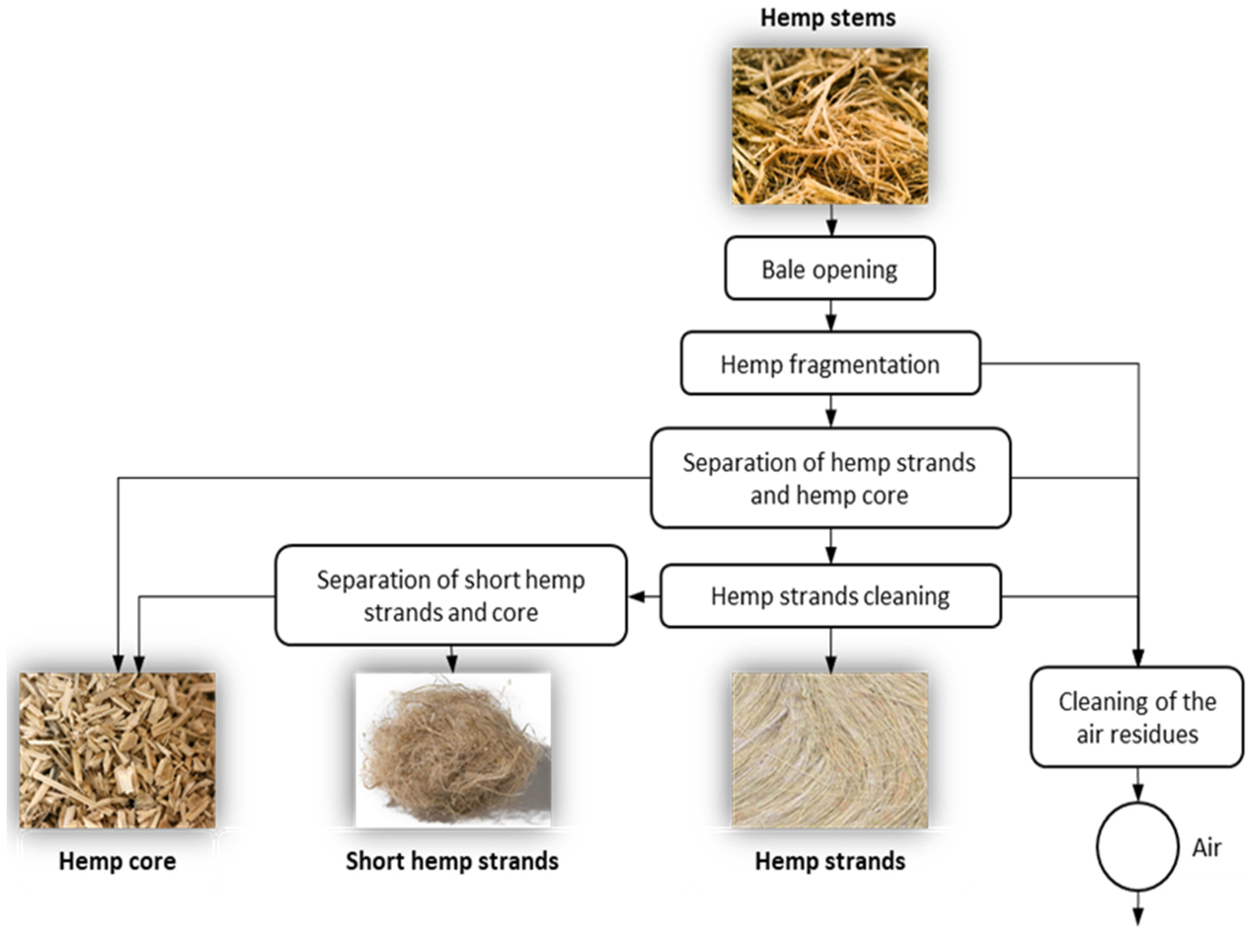

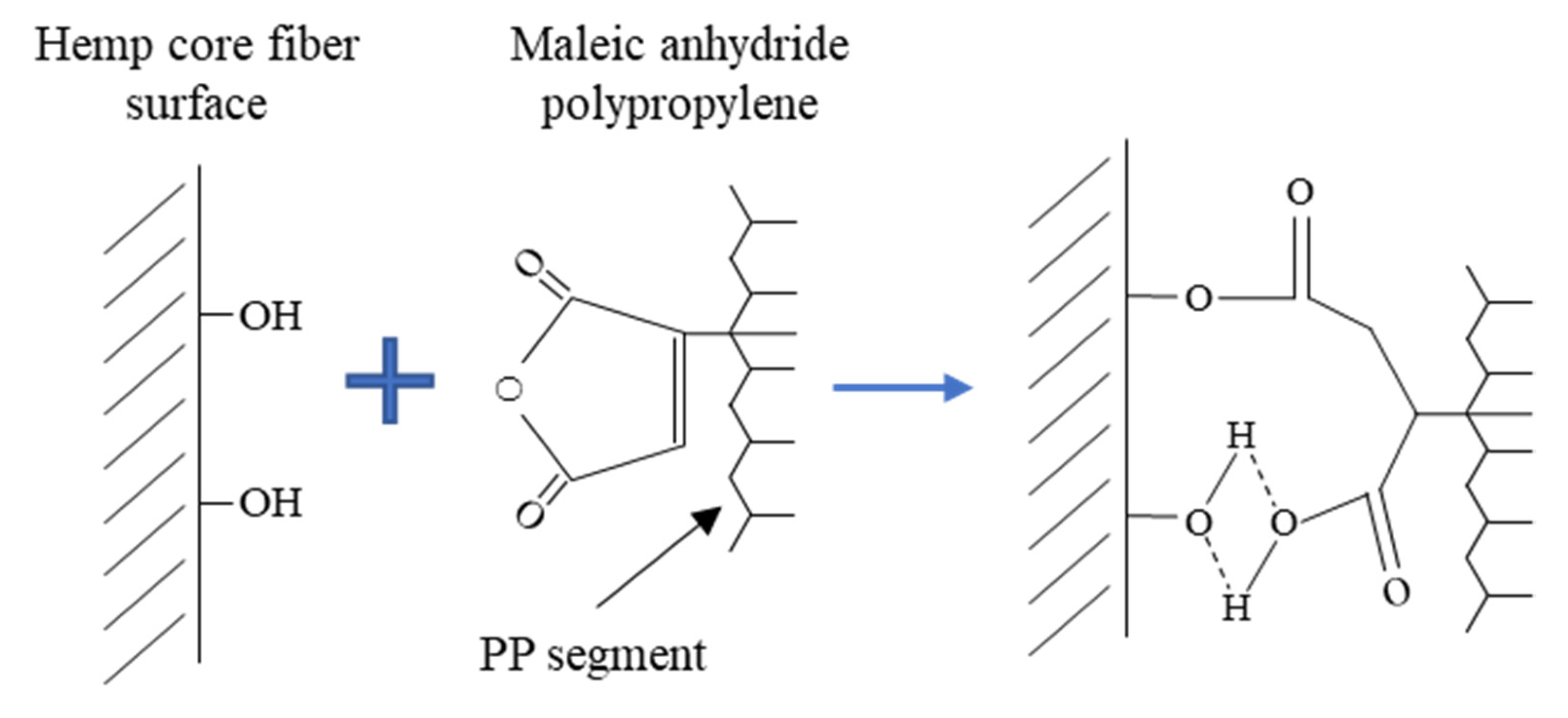
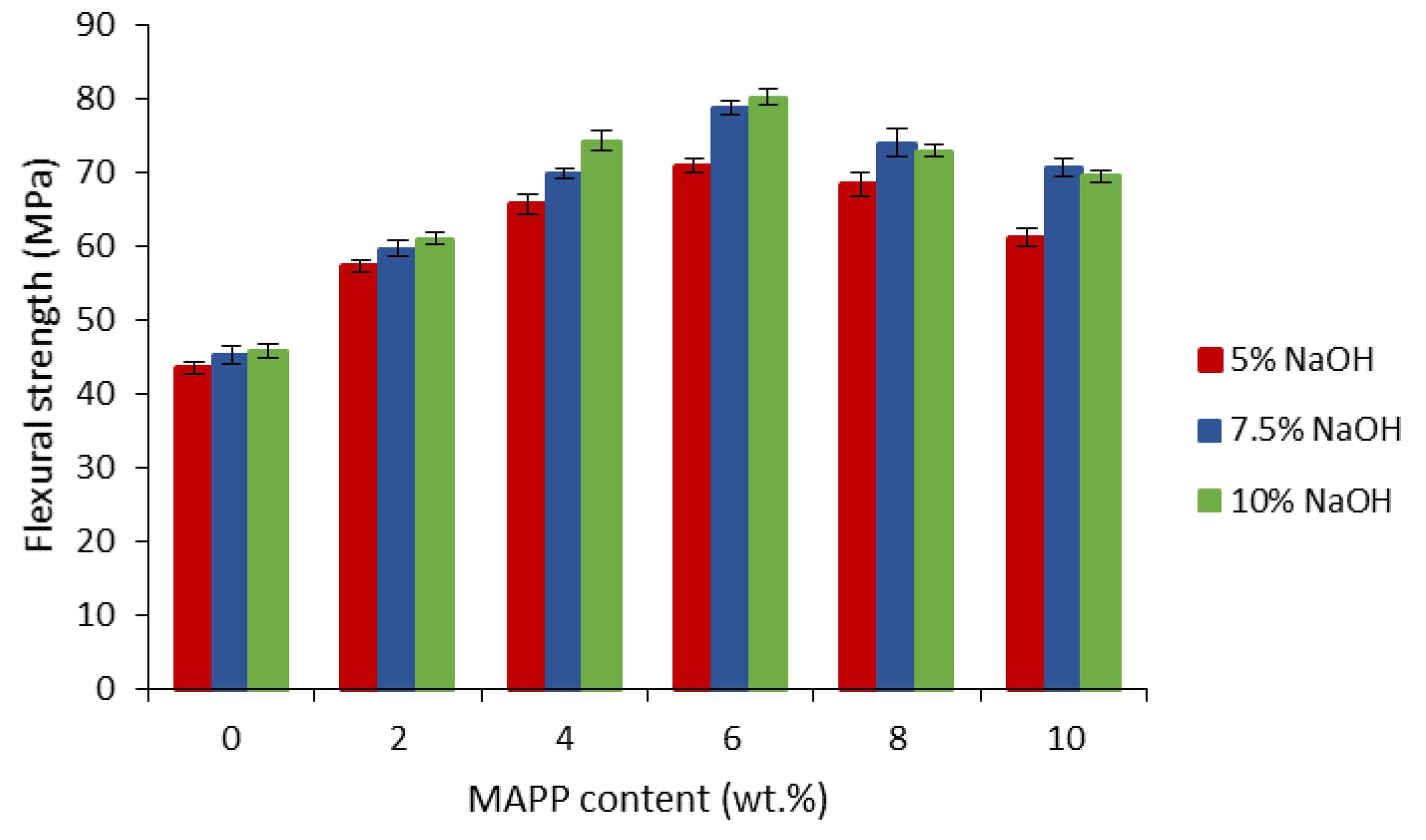
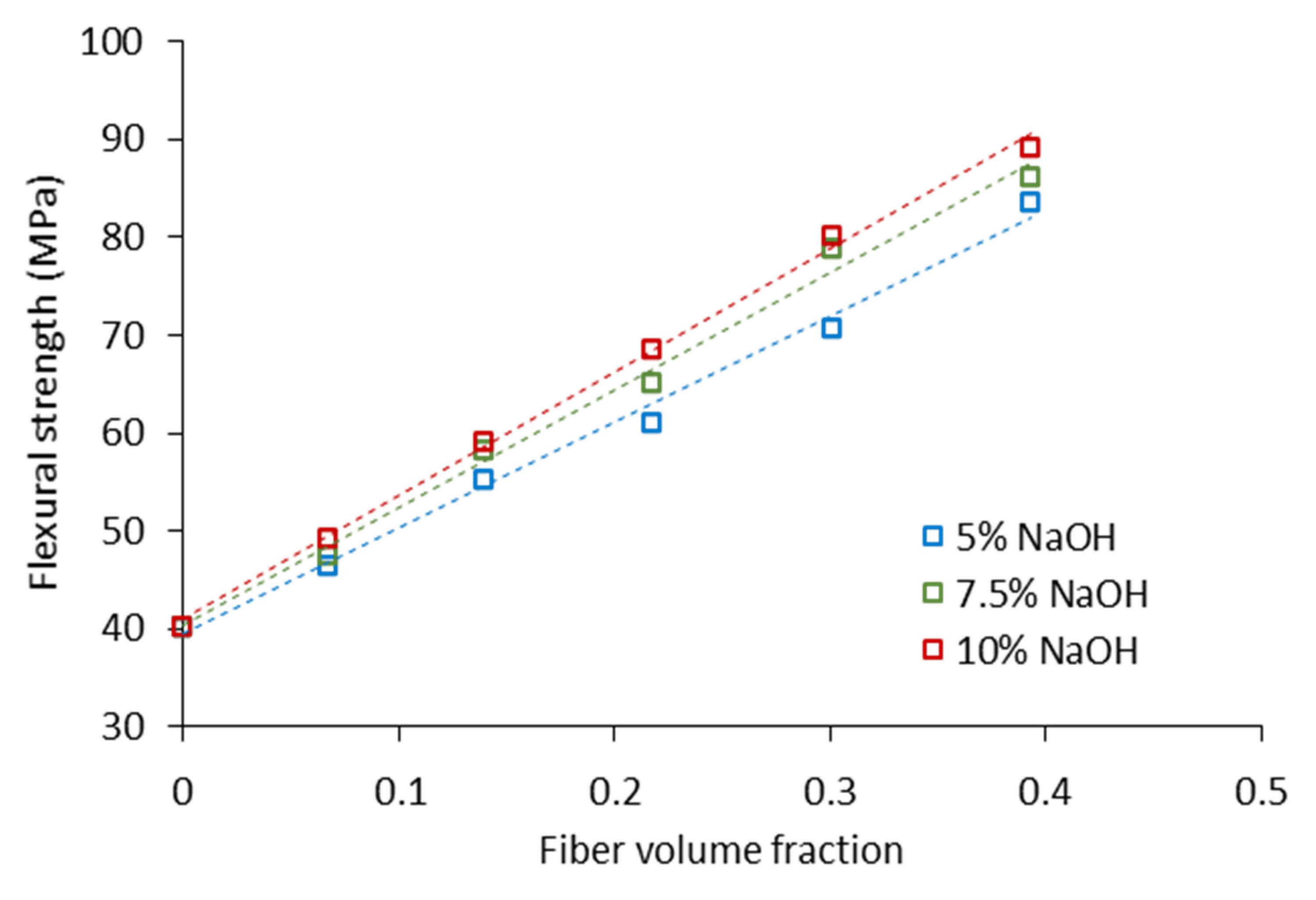

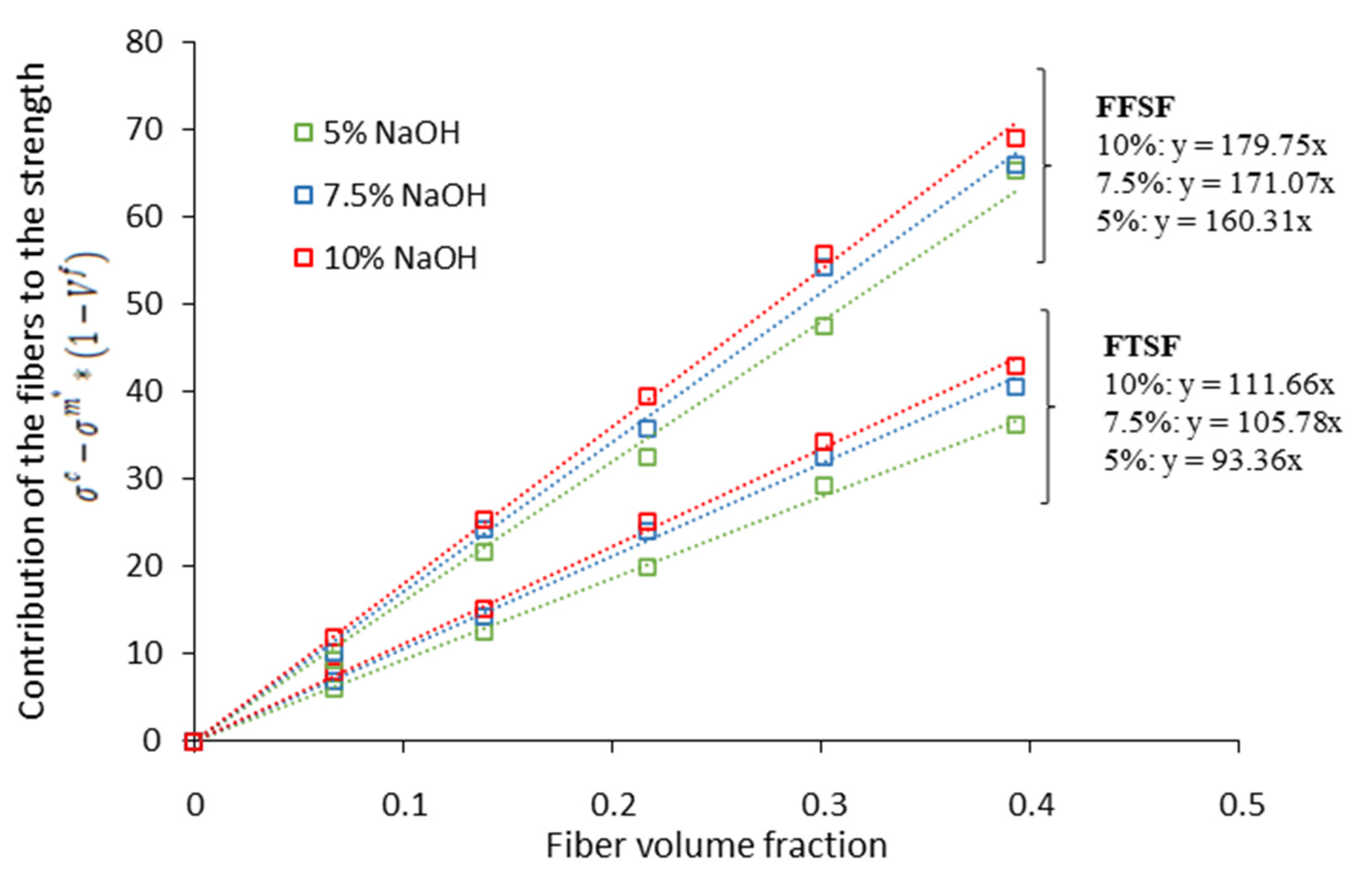

| NaOH | Yield (%) | Kappa Number | lF (µm) | dF (µm) | lF/dF |
|---|---|---|---|---|---|
| 5.0% | 78.1 | 73.2 ± 0.3 | 569 ± 9 | 23.8 ± 0.4 | 23.9 |
| 7.5% | 76.4 | 68.1 ± 0.3 | 689 ± 13 | 24.7 ± 0.3 | 27.9 |
| 10.0% | 66.9 | 57.0 ± 0.4 | 719 ± 10 | 24.6 ± 0.3 | 29.2 |
| 6 wt.% MAPP/fiber | |||||
|---|---|---|---|---|---|
| NaOH | Hemp Core | Vf | σfc | σfm* | εfc |
| (wt.%) | (wt.%) | (MPa) | (MPa) | (%) | |
| 0 | 0 | 0 | 40.20 ± 0.45 | 40.20 ± 0.45 | 9.60 ± 0.39 |
| 5 | 10 | 0.067 | 46.51 ± 0.59 | 40.03 ± 0.41 | 7.89 ± 0.25 |
| 20 | 0.139 | 55.21 ± 0.88 | 38.89 ± 0.49 | 6.89 ± 0.39 | |
| 30 | 0.217 | 61.05 ± 0.41 | 36.39 ± 0.45 | 5.78 ± 0.33 | |
| 40 | 0.301 | 70.85 ± 1.03 | 33.48 ± 0.56 | 4.90 ± 0.48 | |
| 50 | 0.393 | 83.59 ± 1.11 | 30.11 ± 0.50 | 4.11 ± 0.40 | |
| 7.5 | 10 | 0.067 | 47.62 ± 0.93 | 40.15 ± 0.36 | 8.14 ± 0.26 |
| 20 | 0.139 | 58.35 ± 0.82 | 39.48 ± 0.42 | 7.26 ± 0.33 | |
| 30 | 0.217 | 65.12 ± 1.08 | 37.50 ± 0.50 | 6.21 ± 0.42 | |
| 40 | 0.301 | 78.80 ± 0.67 | 35.27 ± 0.33 | 5.41 ± 0.25 | |
| 50 | 0.393 | 86.20 ± 1.14 | 33.33 ± 0.44 | 4.86 ± 0.36 | |
| 10 | 10 | 0.067 | 49.28 ± 1.15 | 40.06 ± 0.44 | 7.92 ± 0.56 |
| 20 | 0.139 | 49.12 ± 1.03 | 38.27 ± 0.34 | 7.12 ± 0.41 | |
| 30 | 0.217 | 68.70 ± 1.22 | 37.33 ± 0.31 | 6.14 ± 0.39 | |
| 40 | 0.301 | 80.20 ± 0.56 | 35.08 ± 0.39 | 5.35 ± 0.44 | |
| 50 | 0.393 | 89.23 ± 0.79 | 33.18 ± 0.29 | 4.82 ± 0.33 | |
| 6 wt.% MAPP/fiber | |||||
|---|---|---|---|---|---|
| NaOH | Hemp Core | VF | σtc | σtm* | εtc |
| (wt.%) | (wt.%) | (MPa) | (MPa) | (%) | |
| 0 | 0 | 0 | 27.60 ± 0.20 | 27.60 ± 0.20 | 9.30 ± 0.20 |
| 5 | 10 | 0.067 | 31.74 ± 0.45 | 27.47 ± 0.28 | 6.84 ± 0.48 |
| 20 | 0.139 | 35.92 ± 0.83 | 27.06 ± 0.33 | 5.24 ± 0.59 | |
| 30 | 0.217 | 39.60 ± 0.66 | 25.19 ± 0.39 | 3.86 ± 0.61 | |
| 40 | 0.301 | 45.77 ± 0.89 | 23.51 ± 0.38 | 3.12 ± 0.53 | |
| 50 | 0.393 | 49.30 ± 0.68 | 21.73 ± 0.45 | 2.58 ± 0.78 | |
| 7.5 | 10 | 0.067 | 32.57 ± 1.01 | 27.48 ± 0.36 | 6.94 ± 0.49 |
| 20 | 0.139 | 37.94 ± 0.55 | 27.54 ± 0.31 | 5.74 ± 0.33 | |
| 30 | 0.217 | 42.90 ± 0.73 | 26.77 ± 0.49 | 4.71 ± 0.58 | |
| 40 | 0.301 | 49.86 ± 0.86 | 24.74 ± 0.30 | 3.63 ± 0.26 | |
| 50 | 0.393 | 54.08 ± 1.11 | 22.14 ± 0.63 | 2.69 ± 0.71 | |
| 10 | 10 | 0.067 | 33.63 ± 0.59 | 27.42 ± 0.21 | 6.30 ± 0.19 |
| 20 | 0.139 | 38.23 ± 0.47 | 26.89 ± 0.52 | 5.10 ± 0.44 | |
| 30 | 0.217 | 45.27 ± 0.99 | 25.84 ± 0.61 | 4.25 ± 0.51 | |
| 40 | 0.301 | 51.83 ± 0.90 | 25.15 ± 0.45 | 3.84 ± 0.35 | |
| 50 | 0.393 | 57.90 ± 1.02 | 24.54 ± 0.79 | 3.58 ± 0.69 | |
| 6 wt.% MAPP/Fiber | |||
|---|---|---|---|
| NaOH | Hemp Core | σtF | fc,t |
| (wt.%) | (wt.%) | (MPa) | (MPa) |
| 5 | 40 | 472 | 0.206 |
| 7.5 | 40 | 548 | 0.197 |
| 10 | 40 | 584 | 0.193 |
| NaOH | Hemp Core | FFSF/FTSF | fc,t | σtF | fc,f | σfF |
|---|---|---|---|---|---|---|
| (wt.%) | (wt.%) | (MPa) | (MPa) | |||
| 5 | 10 | 1.717 | 0.206 | 441 | 0.180 | 758 |
| 20 | 439 | 0.207 | 755 | |||
| 30 | 443 | 0.197 | 761 | |||
| 40 | 472 | 0.194 | 810 | |||
| 50 | 444 | 0.218 | 764 | |||
| 7.5 | 10 | 1.617 | 0.197 | 523 | 0.179 | 847 |
| 20 | 518 | 0.209 | 838 | |||
| 30 | 512 | 0.199 | 829 | |||
| 40 | 548 | 0.203 | 886 | |||
| 50 | 523 | 0.198 | 847 | |||
| 10 | 10 | 1.610 | 0.193 | 622 | 0.178 | 993 |
| 20 | 562 | 0.202 | 901 | |||
| 30 | 597 | 0.190 | 953 | |||
| 40 | 584 | 0.198 | 936 | |||
| 50 | 566 | 0.193 | 909 |
© 2020 by the authors. Licensee MDPI, Basel, Switzerland. This article is an open access article distributed under the terms and conditions of the Creative Commons Attribution (CC BY) license (http://creativecommons.org/licenses/by/4.0/).
Share and Cite
Vilaseca, F.; Serra-Parareda, F.; Espinosa, E.; Rodríguez, A.; Mutjé, P.; Delgado-Aguilar, M. Valorization of Hemp Core Residues: Impact of NaOH Treatment on the Flexural Strength of PP Composites and Intrinsic Flexural Strength of Hemp Core Fibers. Biomolecules 2020, 10, 823. https://doi.org/10.3390/biom10060823
Vilaseca F, Serra-Parareda F, Espinosa E, Rodríguez A, Mutjé P, Delgado-Aguilar M. Valorization of Hemp Core Residues: Impact of NaOH Treatment on the Flexural Strength of PP Composites and Intrinsic Flexural Strength of Hemp Core Fibers. Biomolecules. 2020; 10(6):823. https://doi.org/10.3390/biom10060823
Chicago/Turabian StyleVilaseca, Fabiola, Ferran Serra-Parareda, Eduardo Espinosa, Alejandro Rodríguez, Pere Mutjé, and Marc Delgado-Aguilar. 2020. "Valorization of Hemp Core Residues: Impact of NaOH Treatment on the Flexural Strength of PP Composites and Intrinsic Flexural Strength of Hemp Core Fibers" Biomolecules 10, no. 6: 823. https://doi.org/10.3390/biom10060823
APA StyleVilaseca, F., Serra-Parareda, F., Espinosa, E., Rodríguez, A., Mutjé, P., & Delgado-Aguilar, M. (2020). Valorization of Hemp Core Residues: Impact of NaOH Treatment on the Flexural Strength of PP Composites and Intrinsic Flexural Strength of Hemp Core Fibers. Biomolecules, 10(6), 823. https://doi.org/10.3390/biom10060823










